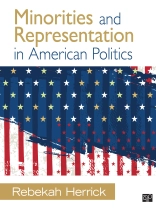Minorities and Representation in American Politics is the first book of its kind to examine underrepresented minorities with a framework based on four types of representation—descriptive, formalistic, symbolic, and substantive. Through this lens, author Rebekah Herrick looks at race, ethnic, gender, and sexual minorities not in isolation but synthesized within every chapter. This enables readers to better recognize both the similarities and differences of groups’ underrepresentation. Herrick also applies her unique and constructive approach to intergroup cooperation and intersectionality, highlighting the impact that groups can have on one another.
قائمة المحتويات
Chapter 1: Minorities and Representation
Who Are Minorities?: Race as a Category
Who Are Minorities?: Ethnicity as a Category
Who Are Minorities?: Gender and Sexual Minorities
Representation
Overview of the Book
Conclusion: Similarities, Differences, and Intersectionality in Representation
Chapter 2: Descriptive Representation and Minorities: Legislatures and Other Elective Offices
Levels of Descriptive Representation in Legislatures
Levels of Descriptive Representation in Executive Positions
What Affects Levels of Descriptive Representation?
Descriptive Representation is Not Sufficient
Conclusion: Similarities, Differences, and Intersectionality
Chapter 3: Minorities and Formalistic Representation: Laws, Institutional Design, and Elections
Formal Representation and the Right to Vote
Electoral Systems
Institutional Design
The Fourteenth Amendment
Conclusion: Similarities, Differences, and Intersectionality
Chapter 4: Policy Representation and Minorities in Legislatures
Key Minority Policy Interests
Does Descriptive Representation Lead to Substantive Representation?
What Affects Policy Representation?
Initiative and Referenda Effects on Minority Interests
Demonstration
Casework/Constituency Services and Pork Barreling by Minority Legislators
Conclusion: Similarities and Differences in Policy Representation
Chapter 5: Minorities and Symbolic Representation
Measuring Minorities′ Attitudes
Levels of Symbolic Representation
What Affects the Symbolic Representation of Minorities?
Symbolic Legislation: Representing Minorities through Symbolic Actions
Conclusion: Decreasing Gaps in Symbolic Representation
Chapter 6: Minority Representation and the Judicial Branch
The Court Systems
Descriptive Representation: The Numbers Game
What Affects Descriptive Representation in the Judicial Branch?
Descriptive and Substantive Representation on the Courts
Key Court Cases
Conclusion: Improving Descriptive Representation but Mixed Record of Courts’ Protection of Minorities
Chapter 7: Representative Bureaucracy
The Influence of Bureaucrats on Policy
Level of Passive Representation
What Affects Passive Representation?
The Effects of Passive Representation on Active Representation
Conclusion: Similarities and Differences in Minority Representation in the Bureaucracy
Chapter 8: Public Opinion and Minority Interests
Attitudes Toward Racial and Ethnic Minorities
Attitudes Toward Women
Attitudes Toward LGBT Persons
Attitudes Toward Affirmative Action
Attitudes Toward LGBT Issues
Attitudes Toward Abortion
Attitudes Toward Immigration
Social Desirability Biases in Surveys
Influences on Americans′ Attitudes Toward Minority Interests
Conclusion: Varied but Increasing Acceptance of Minorities and Their Issues
Chapter 9: Minority Groups and Political Resources
Size and Distribution of Minority Populations
The Voting Eligibility of American Minorities
The Socioeconomic Status of Minorities
The Civic Engagement of Minorities
Conclusion: Variation among Groups in Their Resources
Chapter 10: Acculturation, Group Consciousness, and Cohesion among Individuals with Shared Minority Status
Acculturation: The Extent to Which Minorities Are Part of the Dominant Culture
Group Consciousness: The Extent to Which Minorities See Group Status as Politically Important
Group Cohesion: Level of Shared Beliefs, Values, and Attitudes among Individual Minorities
Variation by Nationality
Effects of Acculturation and Group Consciousness on Voting Cohesion
Conclusion: Similarities, Differences, and Intersectionality among Minority Individuals
Chapter 11: Minorities and Political Participation
The Vote
Other Forms of Political Participation
Explaining Political Participation
The Impact of the Minority Vote
Efforts to Reach Minority Voters
Conclusion: Increased Participation and Power but Differences Remain among Groups
Chapter 12: Minority Movements and Interest Groups
The Civil Rights Movement
The Chicano Movement
The American Indian Movement
The Asian American Movement
Women′s Movements
The LGBT Movement
Social Movement Theories
Interest Groups
Conclusion: Much Change since the 1950s
Chapter 13: Multiminority Coalitions and the Future of Minority Representation
Multiminority Coalitions
Views of the Masses
Coalitions among Elites
The Future: Trends in Representation
Minorities of the Future (Past and Present)
Final Thoughts: Should Minorities Be Lumped Together or Split into Different Groups?












